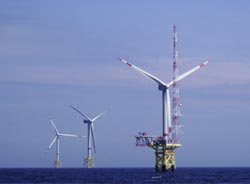Fraunhofer study: Offshore wind energy garanties a stable and economic power supply in future

Offshore wind farm alpha ventus in the German North Sea<br>© Fraunhofer IWES <br>
This is the result of a Fraunhofer IWES study commisioned by the Offshore Wind Energy Foundation. The IWES research team around Dr. Kurt Rohrig has analysed three scenarios. In one of them, a focal point was set on offshore wind energy, whereas in the other ones priorities where onshore wind energy or photovoltaics.
If offshore wind energy is gradually extended from today’s 3 Gigawatts (GW) of installed and currently under construction power up to 54 GW in 2050, total costs for the power system are reduced by 900 Million Euro compared to rapid expansion of onshore wind energy, and even by 6.1 billion Euro compared with a photovoltaics-scenario.
As much as 92 % of this cost advantage account for so-called flexibility costs. When electricity generation varies very much, the costs of compensation by storage, back-up power plants and derating of unusable power are higher. Offshore, howewer, the wind is blowing so constantly that at 340 days of the year electricity can be generated. In addition, the power level can be predicted more accurately than onshore.
Therefore, offshore wind turbines can provide ten times more balancing capacity in order to smooth power supply than onshore systems, and costs are only one quarter. Furthermore, considerable cost savings could be achieved by a North Sea offshore grid for Belgium, Denmark, Germany, the UK, the Netherlands, and Norway that facilitates electricity trade.
Expert contact:
Dr. Kurt Rohrig, kurt.rohrig@iwes.fraunhofer.de,
Dr. Stefan Bofinger, stefan.bofinger@iwes.fraunhofer.de
Weitere Informationen:
http://www.offshore-stiftung.com
Study for download
http://www.iwes.fraunhofer.de/en.html
Fraunhofer IWES
Media Contact
More Information:
http://www.iwes.fraunhofer.de/en.htmlAll latest news from the category: Power and Electrical Engineering
This topic covers issues related to energy generation, conversion, transportation and consumption and how the industry is addressing the challenge of energy efficiency in general.
innovations-report provides in-depth and informative reports and articles on subjects ranging from wind energy, fuel cell technology, solar energy, geothermal energy, petroleum, gas, nuclear engineering, alternative energy and energy efficiency to fusion, hydrogen and superconductor technologies.
Newest articles

A universal framework for spatial biology
SpatialData is a freely accessible tool to unify and integrate data from different omics technologies accounting for spatial information, which can provide holistic insights into health and disease. Biological processes…

How complex biological processes arise
A $20 million grant from the U.S. National Science Foundation (NSF) will support the establishment and operation of the National Synthesis Center for Emergence in the Molecular and Cellular Sciences (NCEMS) at…

Airborne single-photon lidar system achieves high-resolution 3D imaging
Compact, low-power system opens doors for photon-efficient drone and satellite-based environmental monitoring and mapping. Researchers have developed a compact and lightweight single-photon airborne lidar system that can acquire high-resolution 3D…





















